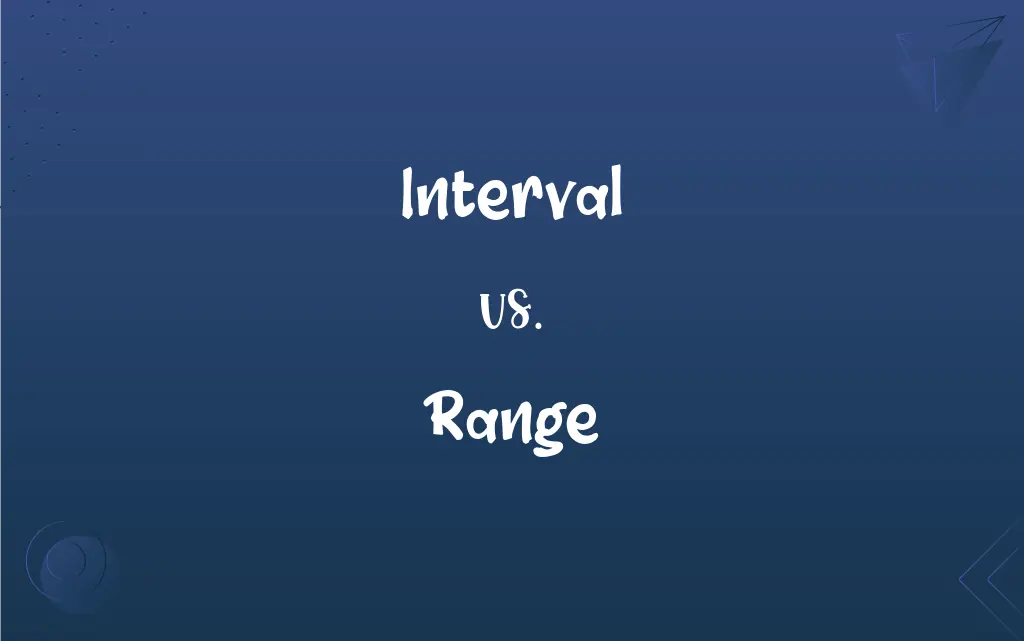Interval vs. Range: What's the Difference?
Edited by Janet White || By Harlon Moss || Published on November 13, 2023
An interval is a space or duration between things; range refers to the extent, scope, or variability of something.

Key Differences
An interval refers to the gap or distance between two points, which can be physical or temporal. It is often used to describe a pause or break in activity, or a specific distance between objects. In contrast, range describes the extent or scope of something, from one end to another, and is often associated with the variation or diversity within a set or series.
Intervals can be measured and defined numerically, such as the interval between the numbers 5 and 10, which is 5 units. The concept of an interval can also apply to time, as in the interval between two events. Range, however, encompasses the totality of values in a dataset or the limits within which something varies, such as the range of temperatures over a week.
When it comes to music, an interval is the difference in pitch between two notes. A musician might discuss the intervals within a scale or a piece. Range in music, however, would refer to the extent of pitches that a voice or instrument can produce, from the lowest to the highest note.
In mathematics, an interval may represent a set of numbers between a pair of given numbers, including both real and imaginary numbers. A range in mathematics, especially in statistics, is the difference between the lowest and highest values in a dataset, reflecting the dataset’s dispersion.
An interval can also signify a lapse of time or a break, such as the interval between workout sessions or acts in a play. The range is used to express the full sweep or array of possibilities, like the range of options available in a car model, from the basic to the luxury edition.
ADVERTISEMENT
Comparison Chart
Definition
A gap or space between two points.
The extent or scope of something.
Usage in Math
Set of numbers between two values.
The difference between the highest and lowest values.
Context
Temporal breaks or spatial distances.
Spectrum or scope of different variations.
Music
Difference in pitch between two notes.
The total span of notes an instrument or voice can produce.
Measurement
Can refer to a period or distance.
Indicates the scope of variability or capacity.
ADVERTISEMENT
Interval and Range Definitions
Interval
A space between two objects or points.
Plant the bulbs at intervals of six inches apart.
Range
The scope of different things.
The store offers a wide range of products.
Interval
A specific distance in a sequence or scale.
The intervals on this scale are marked in tenths of a unit.
Range
The variation between upper and lower limits on a particular scale.
This thermometer has a range from -10 to 50 degrees Celsius.
Interval
A period of time between events.
The bus arrives at regular intervals of 15 minutes.
Range
The extent of area covered.
The ranger explained that the mountain range stretches over two states.
Interval
A pause or intermission.
There was a 20-minute interval between the two acts of the play.
Range
A series or variety of something.
The new model of cars comes in a range of colors and finishes.
Interval
The difference in pitch between two musical notes.
A perfect fifth is a musical interval found in many melodies.
Range
The maximum distance over which something can reach or make an impact.
The artillery has a range of 30 kilometers.
Interval
A space between objects, points, or units, especially when making uniform amounts of separation
We set up hurdles at intervals of 15 yards around the track.
Range
A number or grouping of things in the same category or within specified limits
Offers a range of financial services.
Jobs at different pay ranges.
Range
An amount or extent of variation
A wide price range.
The range of genetic diversity.
FAQs
Can range be negative?
No, a range, being the difference between the highest and lowest values, is always non-negative.
Does range refer to geographical features as well?
Yes, range can also refer to a chain of mountains or hills.
How is range used in statistics?
Range is used to measure the dispersion of a dataset in statistics.
Are intervals used in statistics?
Yes, intervals can be used to describe confidence intervals in statistics.
What is an interval?
An interval is the distance or time between two points or events.
Can intervals be negative?
Temporally no, but in mathematics, intervals can include negative values.
What is a range?
A range is the scope or extent of different variations within a set or scale.
How do intervals relate to musical scales?
Intervals are the gaps between notes in a musical scale.
Is an interval always a fixed value?
Intervals can be fixed or variable depending on the context.
What is the difference between an interval and duration?
Interval emphasizes the gap between events, while duration focuses on the length of a single event.
Can 'interval' and 'range' be used interchangeably?
No, they refer to different concepts and are not interchangeable.
Does range affect the quality of a data set?
Range can indicate the variability in a data set but doesn't necessarily reflect quality.
What is an example of a time interval?
The time interval between trains arriving at a station.
Can 'interval' refer to a mathematical function?
Yes, it can denote the domain or range within which a function operates.
Does range apply to frequencies?
Yes, range applies to frequencies, like the range of human hearing.
Can the interval be a decimal or fraction?
Yes, intervals can be expressed as decimals or fractions.
Is the term 'range' used in cooking?
Yes, 'range' can refer to a stove or the variety of cooking temperatures.
What is a typical use of 'interval' in exercise?
Interval training involves alternating between periods of high and low intensity.
How does 'range' apply to a singer?
It refers to the spectrum of notes that a singer can perform.
What does a wide range indicate in a set of data?
It indicates a large difference between the smallest and largest values in the data set.
About Author
Written by
Harlon MossHarlon is a seasoned quality moderator and accomplished content writer for Difference Wiki. An alumnus of the prestigious University of California, he earned his degree in Computer Science. Leveraging his academic background, Harlon brings a meticulous and informed perspective to his work, ensuring content accuracy and excellence.
Edited by
Janet WhiteJanet White has been an esteemed writer and blogger for Difference Wiki. Holding a Master's degree in Science and Medical Journalism from the prestigious Boston University, she has consistently demonstrated her expertise and passion for her field. When she's not immersed in her work, Janet relishes her time exercising, delving into a good book, and cherishing moments with friends and family.
































































